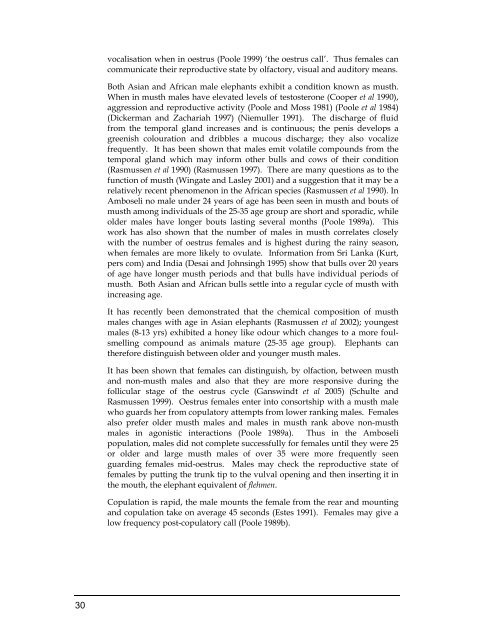Elephants Elephants - Wildpro - Twycross Zoo
Elephants Elephants - Wildpro - Twycross Zoo
Elephants Elephants - Wildpro - Twycross Zoo
You also want an ePaper? Increase the reach of your titles
YUMPU automatically turns print PDFs into web optimized ePapers that Google loves.
30<br />
vocalisation when in oestrus (Poole 1999) ‘the oestrus call’. Thus females can<br />
communicate their reproductive state by olfactory, visual and auditory means.<br />
Both Asian and African male elephants exhibit a condition known as musth.<br />
When in musth males have elevated levels of testosterone (Cooper et al 1990),<br />
aggression and reproductive activity (Poole and Moss 1981) (Poole et al 1984)<br />
(Dickerman and Zachariah 1997) (Niemuller 1991). The discharge of fluid<br />
from the temporal gland increases and is continuous; the penis develops a<br />
greenish colouration and dribbles a mucous discharge; they also vocalize<br />
frequently. It has been shown that males emit volatile compounds from the<br />
temporal gland which may inform other bulls and cows of their condition<br />
(Rasmussen et al 1990) (Rasmussen 1997). There are many questions as to the<br />
function of musth (Wingate and Lasley 2001) and a suggestion that it may be a<br />
relatively recent phenomenon in the African species (Rasmussen et al 1990). In<br />
Amboseli no male under 24 years of age has been seen in musth and bouts of<br />
musth among individuals of the 25-35 age group are short and sporadic, while<br />
older males have longer bouts lasting several months (Poole 1989a). This<br />
work has also shown that the number of males in musth correlates closely<br />
with the number of oestrus females and is highest during the rainy season,<br />
when females are more likely to ovulate. Information from Sri Lanka (Kurt,<br />
pers com) and India (Desai and Johnsingh 1995) show that bulls over 20 years<br />
of age have longer musth periods and that bulls have individual periods of<br />
musth. Both Asian and African bulls settle into a regular cycle of musth with<br />
increasing age.<br />
It has recently been demonstrated that the chemical composition of musth<br />
males changes with age in Asian elephants (Rasmussen et al 2002); youngest<br />
males (8-13 yrs) exhibited a honey like odour which changes to a more foulsmelling<br />
compound as animals mature (25-35 age group). <strong>Elephants</strong> can<br />
therefore distinguish between older and younger musth males.<br />
It has been shown that females can distinguish, by olfaction, between musth<br />
and non-musth males and also that they are more responsive during the<br />
follicular stage of the oestrus cycle (Ganswindt et al 2005) (Schulte and<br />
Rasmussen 1999). Oestrus females enter into consortship with a musth male<br />
who guards her from copulatory attempts from lower ranking males. Females<br />
also prefer older musth males and males in musth rank above non-musth<br />
males in agonistic interactions (Poole 1989a). Thus in the Amboseli<br />
population, males did not complete successfully for females until they were 25<br />
or older and large musth males of over 35 were more frequently seen<br />
guarding females mid-oestrus. Males may check the reproductive state of<br />
females by putting the trunk tip to the vulval opening and then inserting it in<br />
the mouth, the elephant equivalent of flehmen.<br />
Copulation is rapid, the male mounts the female from the rear and mounting<br />
and copulation take on average 45 seconds (Estes 1991). Females may give a<br />
low frequency post-copulatory call (Poole 1989b).

















